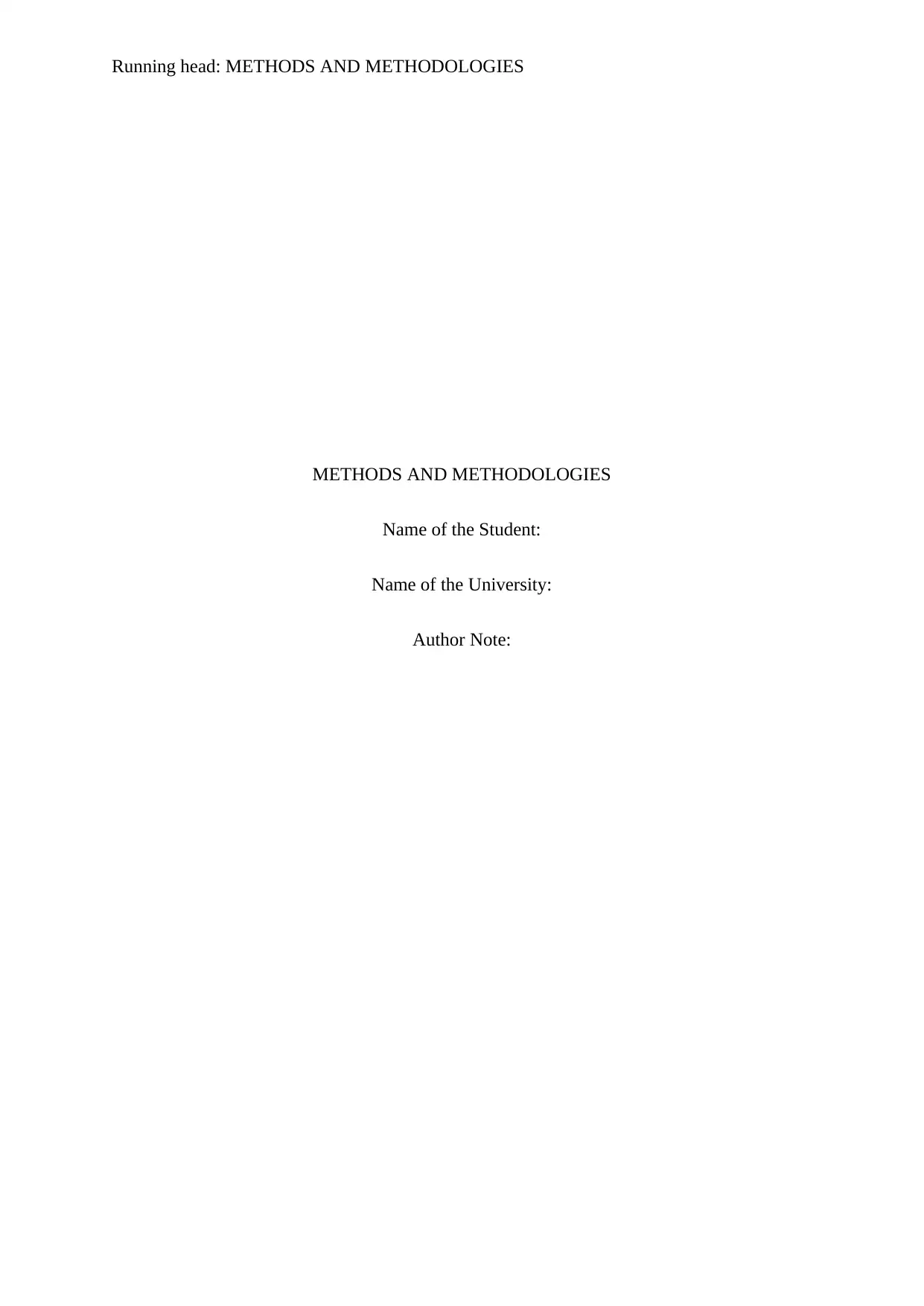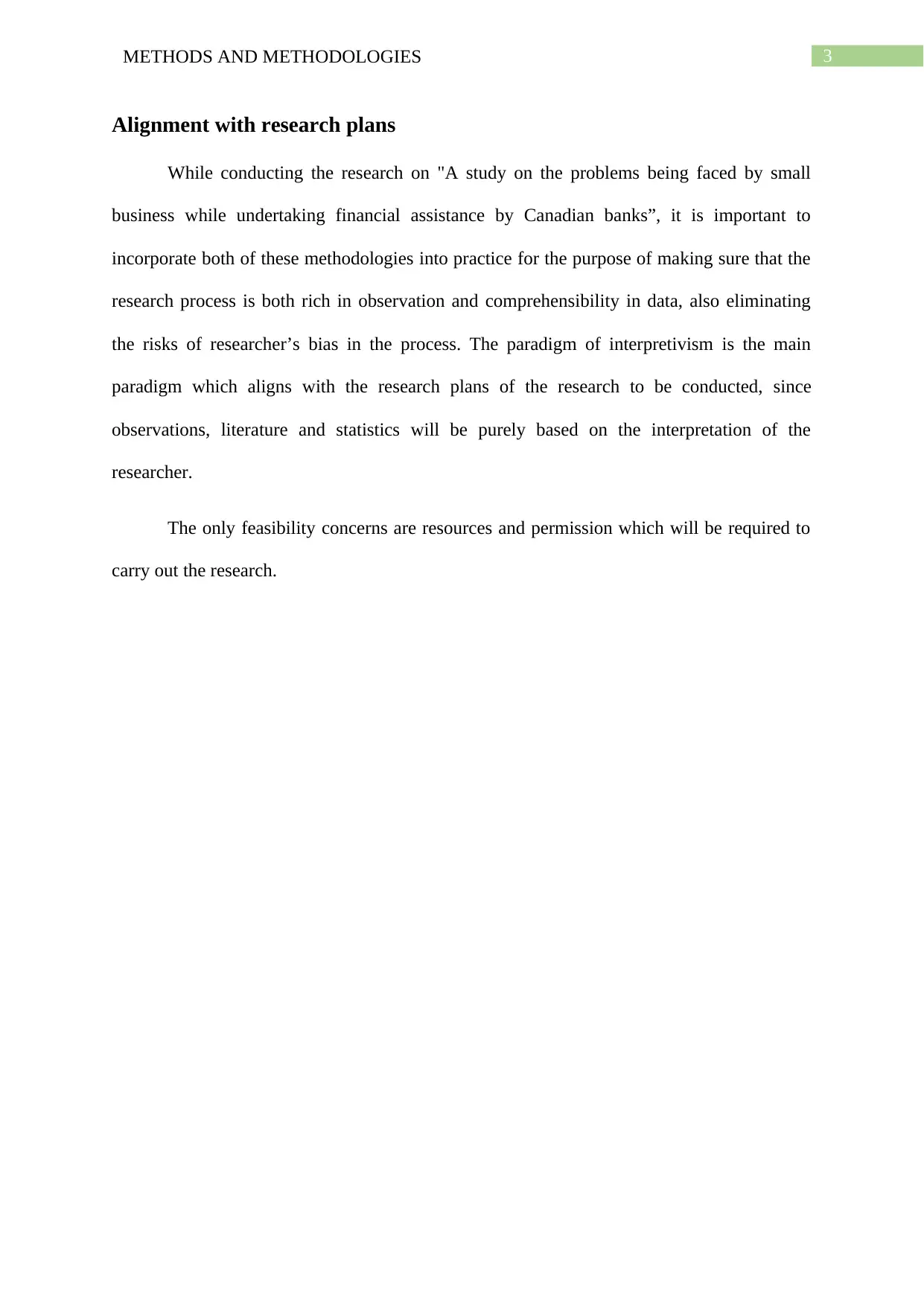Comparative Analysis of Research Methodologies for Management Studies
VerifiedAdded on 2023/04/22
|6
|1008
|227
Report
AI Summary
This report provides a comparative analysis of research methodologies and paradigms used in two management studies: Saini & Budhwar (2008) and Şendoğ du, Kocabacak, & Güven (2013). The report examines the methodologies, including qualitative and quantitative approaches, and the underlying paradigms of interpretivism and positivism. It evaluates the advantages and disadvantages of each methodology and assesses their suitability for a research study on the problems faced by small businesses in obtaining financial assistance from Canadian banks. The analysis highlights the importance of aligning methodologies and paradigms with research objectives, emphasizing the potential benefits of integrating both qualitative and quantitative approaches to mitigate researcher bias and ensure comprehensive data collection. The report concludes by suggesting that the interpretivism paradigm aligns well with the proposed research plans, with feasibility concerns related to resource and permission acquisition.

Running head: METHODS AND METHODOLOGIES
METHODS AND METHODOLOGIES
Name of the Student:
Name of the University:
Author Note:
METHODS AND METHODOLOGIES
Name of the Student:
Name of the University:
Author Note:
Paraphrase This Document
Need a fresh take? Get an instant paraphrase of this document with our AI Paraphraser

1METHODS AND METHODOLOGIES
Introduction
Methodology and research paradigm are lie at the heart of any research process, to
align with the goals and objectives which the research will be meeting in the due course
(Kumar, 2019). Paradigms in research vary according to the methodology of a research. The
main idea is that the overview or the assumptions about how things work in general, should
comply with the methodology adopted in the research process (Fellows, Fellows & Liu,
2015). The purpose of this essay is to compare and evaluate the characteristics of the
methodologies and paradigms used in two specific articles: Saini, D.S. & Budhwar, P.S.
(2008) ‘Managing the human resource in Indian SMEs: The role of indigenous realities’.
Journal of World Business, 43(4), pp. 417-434., and Şendoğ du, A.A., Kocabacak, A. &
Güven, Ş. (2013) ‘The Relationship between Human Resource Management Practices and
Organizational Commitment: A Field Study’. Social and Behavioral Sciences, 99, pp. 818-
827, and check if those possibly align with the research study which will be conducted on "A
study on the problems being faced by small business while undertaking financial assistance
by Canadian banks."
Methodologies
The article by Saini and Budhwar (2008) focuses on a more qualitative methodology
of research. In this, they simply observe from a sample of two small sized businesses one of
which happen to be a family business. The objective of the research was to find out how the
HRM policies and intervention in SME’s in India play a part in motivating the workforce of
the organizations. The research takes in several considerations, such as social support,
employee involvement and employee relations, and then analyses how each sample
approaches these criteria, to arrive at a qualitative interpretation of the issue. The main
advantage of this research methodology is that it is based in human observations and
interpretation. However, the disadvantage is that it is highly subject to researcher’s biasness.
Introduction
Methodology and research paradigm are lie at the heart of any research process, to
align with the goals and objectives which the research will be meeting in the due course
(Kumar, 2019). Paradigms in research vary according to the methodology of a research. The
main idea is that the overview or the assumptions about how things work in general, should
comply with the methodology adopted in the research process (Fellows, Fellows & Liu,
2015). The purpose of this essay is to compare and evaluate the characteristics of the
methodologies and paradigms used in two specific articles: Saini, D.S. & Budhwar, P.S.
(2008) ‘Managing the human resource in Indian SMEs: The role of indigenous realities’.
Journal of World Business, 43(4), pp. 417-434., and Şendoğ du, A.A., Kocabacak, A. &
Güven, Ş. (2013) ‘The Relationship between Human Resource Management Practices and
Organizational Commitment: A Field Study’. Social and Behavioral Sciences, 99, pp. 818-
827, and check if those possibly align with the research study which will be conducted on "A
study on the problems being faced by small business while undertaking financial assistance
by Canadian banks."
Methodologies
The article by Saini and Budhwar (2008) focuses on a more qualitative methodology
of research. In this, they simply observe from a sample of two small sized businesses one of
which happen to be a family business. The objective of the research was to find out how the
HRM policies and intervention in SME’s in India play a part in motivating the workforce of
the organizations. The research takes in several considerations, such as social support,
employee involvement and employee relations, and then analyses how each sample
approaches these criteria, to arrive at a qualitative interpretation of the issue. The main
advantage of this research methodology is that it is based in human observations and
interpretation. However, the disadvantage is that it is highly subject to researcher’s biasness.

2METHODS AND METHODOLOGIES
On the other hand, the article by Şendoğ du, Kocabacak, A. and Güven (2013) take a
more quantitative approach towards their study of how HRM policies lead to organizational
commitment. The research methodology in this case is both qualitative and quantitative, but
focusing more on quantitative approach, based on extensive statistical figures. Peffer’s scale
of HRM and Moodway and Steers’ organizational commitment scale were used in the
research process. Data in the research has been analysed using descriptive statistics.
Correlations, multiple regressions and statistical regressions have been used in order to
explore the relationship between the variables in the study. Hence, it can be understood that
focus has mainly been on quantitative methodology of research. The advantage of this
methodology is that it provides for accurate data and easily understandable data. However, it
does not provide an in-depth insight into why a particular thing is happen in the setting.
Paradigms
Saini and Budhwar (2018) have taken the interpretivism paradigm in their research, as
they have used their own interpretation of the people involved in the situation to do the
analysis of the qualitative research, from an individual perspective. The advantage of this
research is that it supports primary observation and description of real world situations. The
disadvantage is however the fact that it is highly subject to researcher’s bias.
Şendoğ du, Kocabacak, A. and Güven (2013) on the other hand have used the
paradigm of positivism in their research, testing hypothesis with the help of several tools of
quantitative data analysis, to arrive at an objective conclusion. The advantage of this research
paradigm is that it follows a well-defined structure in research. However, it is subject to
change in human behaviour.
On the other hand, the article by Şendoğ du, Kocabacak, A. and Güven (2013) take a
more quantitative approach towards their study of how HRM policies lead to organizational
commitment. The research methodology in this case is both qualitative and quantitative, but
focusing more on quantitative approach, based on extensive statistical figures. Peffer’s scale
of HRM and Moodway and Steers’ organizational commitment scale were used in the
research process. Data in the research has been analysed using descriptive statistics.
Correlations, multiple regressions and statistical regressions have been used in order to
explore the relationship between the variables in the study. Hence, it can be understood that
focus has mainly been on quantitative methodology of research. The advantage of this
methodology is that it provides for accurate data and easily understandable data. However, it
does not provide an in-depth insight into why a particular thing is happen in the setting.
Paradigms
Saini and Budhwar (2018) have taken the interpretivism paradigm in their research, as
they have used their own interpretation of the people involved in the situation to do the
analysis of the qualitative research, from an individual perspective. The advantage of this
research is that it supports primary observation and description of real world situations. The
disadvantage is however the fact that it is highly subject to researcher’s bias.
Şendoğ du, Kocabacak, A. and Güven (2013) on the other hand have used the
paradigm of positivism in their research, testing hypothesis with the help of several tools of
quantitative data analysis, to arrive at an objective conclusion. The advantage of this research
paradigm is that it follows a well-defined structure in research. However, it is subject to
change in human behaviour.
⊘ This is a preview!⊘
Do you want full access?
Subscribe today to unlock all pages.

Trusted by 1+ million students worldwide

3METHODS AND METHODOLOGIES
Alignment with research plans
While conducting the research on "A study on the problems being faced by small
business while undertaking financial assistance by Canadian banks”, it is important to
incorporate both of these methodologies into practice for the purpose of making sure that the
research process is both rich in observation and comprehensibility in data, also eliminating
the risks of researcher’s bias in the process. The paradigm of interpretivism is the main
paradigm which aligns with the research plans of the research to be conducted, since
observations, literature and statistics will be purely based on the interpretation of the
researcher.
The only feasibility concerns are resources and permission which will be required to
carry out the research.
Alignment with research plans
While conducting the research on "A study on the problems being faced by small
business while undertaking financial assistance by Canadian banks”, it is important to
incorporate both of these methodologies into practice for the purpose of making sure that the
research process is both rich in observation and comprehensibility in data, also eliminating
the risks of researcher’s bias in the process. The paradigm of interpretivism is the main
paradigm which aligns with the research plans of the research to be conducted, since
observations, literature and statistics will be purely based on the interpretation of the
researcher.
The only feasibility concerns are resources and permission which will be required to
carry out the research.
Paraphrase This Document
Need a fresh take? Get an instant paraphrase of this document with our AI Paraphraser

4METHODS AND METHODOLOGIES

5METHODS AND METHODOLOGIES
References
Saini, D.S. & Budhwar, P.S. (2008) ‘Managing the human resource in Indian SMEs: The role
of indigenous realities’. Journal of World Business, 43(4), pp. 417-434.
Şendoğ du, A.A., Kocabacak, A. & Güven, Ş. (2013) ‘The Relationship between Human
Resource Management Practices and Organizational Commitment: A Field Study’. Social
and Behavioral Sciences, 99, pp. 818-827.
Kumar, R. (2019). Research methodology: A step-by-step guide for beginners. Sage
Publications Limited.
Fellows, R., Fellows, R. F., & Liu, A. M. (2015). Research methods for construction. John
Wiley & Sons.
References
Saini, D.S. & Budhwar, P.S. (2008) ‘Managing the human resource in Indian SMEs: The role
of indigenous realities’. Journal of World Business, 43(4), pp. 417-434.
Şendoğ du, A.A., Kocabacak, A. & Güven, Ş. (2013) ‘The Relationship between Human
Resource Management Practices and Organizational Commitment: A Field Study’. Social
and Behavioral Sciences, 99, pp. 818-827.
Kumar, R. (2019). Research methodology: A step-by-step guide for beginners. Sage
Publications Limited.
Fellows, R., Fellows, R. F., & Liu, A. M. (2015). Research methods for construction. John
Wiley & Sons.
⊘ This is a preview!⊘
Do you want full access?
Subscribe today to unlock all pages.

Trusted by 1+ million students worldwide
1 out of 6
Related Documents
Your All-in-One AI-Powered Toolkit for Academic Success.
+13062052269
info@desklib.com
Available 24*7 on WhatsApp / Email
![[object Object]](/_next/static/media/star-bottom.7253800d.svg)
Unlock your academic potential
Copyright © 2020–2025 A2Z Services. All Rights Reserved. Developed and managed by ZUCOL.





